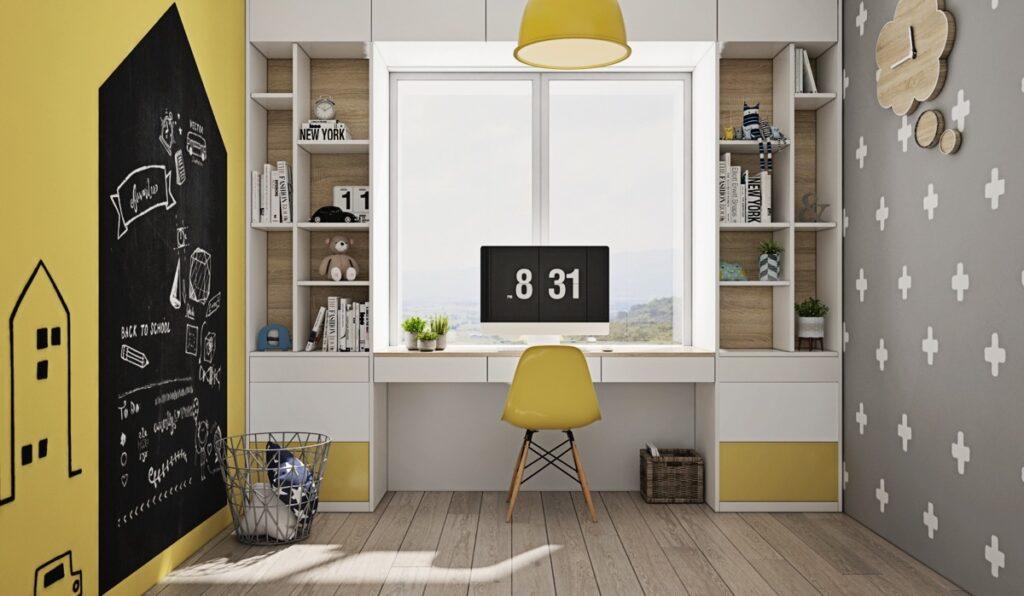
In today’s fast-paced world, having a dedicated space to study or work is more important than ever. Whether you’re a student, a remote professional, or someone who loves to read and learn, the right study room design ideas can help you create a space that supports focus, productivity, and comfort. From choosing the ideal location to incorporating functional and stylish elements, a well-designed study room can make a big impact on your daily routine.
If you’re seeking inspiration for your home workspace, here are some creative and practical ways to shape a study environment that fits your needs.
1. Choose the Right Location for Your Study Space
A productive study setup begins with choosing the right spot. Ideally, pick a quiet area of your home away from distractions like the TV or kitchen. If a full room isn’t available, consider transforming a corner of your bedroom or living room into a focused work zone.
Pro Tip: Position your workspace near a window for natural light—it improves mood and helps you stay alert during long hours of work or study.
2. Embrace Minimalist Design Principles
One of the most effective approaches to designing a study room is keeping it minimal. Clean lines, neutral colors, and simple decor help reduce distractions and encourage focus.
Key Elements of a Minimalist Study Setup:
- A clean desk with built-in storage.
- An ergonomic chair that supports good posture.
- Floating shelves for books and supplies.
- A splash of inspiration with framed art or quotes.
3. Smart Storage Solutions
A clutter-free space leads to a clutter-free mind. Efficient storage is vital for any home study setup. Use shelves, baskets, and organizers to maintain a tidy and functional environment.
Storage Tips:
- Bookshelves for textbooks and decor.
- Drawer trays for pens, paper, and gadgets.
- Wall-mounted organizers for calendars and documents.
- Woven baskets or bins for miscellaneous items.
4. Prioritize Ergonomic Comfort
Long study sessions can strain your body if your setup isn’t ergonomic. Investing in the right furniture is crucial for both comfort and health.
Ergonomic Must-Haves:
- A supportive, adjustable chair.
- A height-adjustable desk for sitting or standing.
- A footrest to enhance circulation.
5. Add a Cozy Reading Nook
For moments of quiet reading or reflection, carve out a corner with soft lighting and a comfortable seat. A reading nook offers a break from the screen while keeping you in your productive zone.
Reading Nook Essentials:
- Soft lighting from a floor or table lamp.
- A plush armchair or compact loveseat.
- Floating shelves for your current reads.
- Cushions or throws for added comfort.
6. Reflect Your Personality
Make your workspace feel like your own. Infuse personality with meaningful decor, fun accessories, or personal items that bring you joy and motivation.
Ways to Personalize Your Study Environment:
- Display inspiring artwork or motivational prints.
- Add greenery with easy-care indoor plants.
- Use your favorite mug, pen holder, or clock for charm and character.
Pro Tip: Choose low-maintenance plants like snake plants or succulents—they boost air quality and bring life to your room.
7. Use Thoughtful Lighting
Lighting plays a key role in creating an effective study area. A combination of task and ambient lighting ensures clarity without causing eye strain.
Lighting Suggestions:
- Desk lamp with adjustable brightness.
- Ceiling or wall lighting for overall warmth.
- Accent lighting like LED strips or pendants to elevate style.
8. Experiment with Colors
Color can influence your focus, mood, and creativity. Choose shades that align with the mood you want to cultivate in your study setup.
Color Combos to Consider:
- Blue & White: Calm and clean.
- Green & Beige: Natural and refreshing.
- Gray & Yellow: Balanced and energizing.
9. Make It Tech-Friendly
In our digital world, your study zone should support your tech needs. Keep cords tidy and your gear accessible with smart organization.
Tips for a Tech-Savvy Study Setup:
- Use cable organizers or trays.
- Incorporate a wireless keyboard and mouse.
- Add a monitor stand or laptop riser for comfort.
- Include a smart speaker or timer for productivity.
Conclusion
Designing the perfect study environment doesn’t have to be overwhelming. Whether you’re preparing for exams, working remotely, or enjoying quiet reading time, the right setup can boost your focus, mood, and efficiency.
Start with the ideas that resonate most with your needs and space. With a little creativity, you can build a personalized and productive study area you’ll love spending time in. Do contact City Interior for any kind of recommendation.

